Custom apparel has long been the job of heat-transfer vinyl (HTV); tried, tested, and trusted by many print businesses and their customers. Direct-to-film (DTF) transfer, however, has enjoyed a boom in popularity, emerging as a genuine solution for customising fabrics and beyond.
HTV and DTF each have benefits that make them more suitable in certain situations. In this article, we will explain these advantages and compare the two technologies to help you determine which option is right for your next print job.
What is DTF?

A large DTF graphic on a white t-shirt
DTF printing is a multi-step process that uses inkjet technology to print directly onto a transfer film. A powder-based adhesive is applied to the ink and cured at a high temperature, ready for application to the substrate. The film is then heat-pressed to the garment, the heat activating the adhesive and transferring the design.
Once the adhesive is cured, the film can be stored for up to a month before application without losing any significant image quality.
What is HTV?
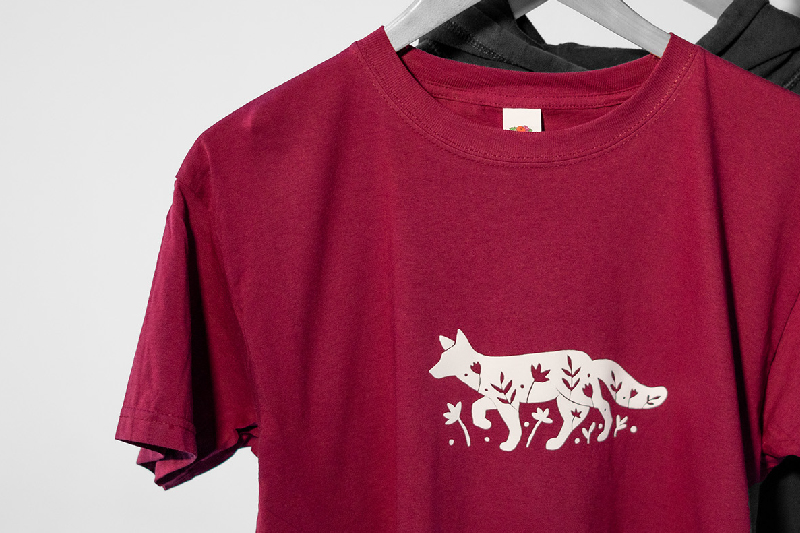
A red shirt with a white fox HTV transfer on it
HTV transfer is an umbrella term for methods of applying vinyl graphics to garments. HTV is either cut or printed and then cut to the desired shape using a vinyl cutter or eco-solvent printer/cutter. The design is then adhered to an item using heat and pressure after the excess has been removed or weeded.
The process is relatively simple for both beginners and experienced users, so it’s a great place to start. Simply, create a design, add cut lines, cut it out, weed and heat-press. The time taken to create complex HTV designs is certainly worth it as it lets you produce great results with little experience.
5 Questions to Ask When Choosing Between HTV and DTF
1. How Complex is Your Design?
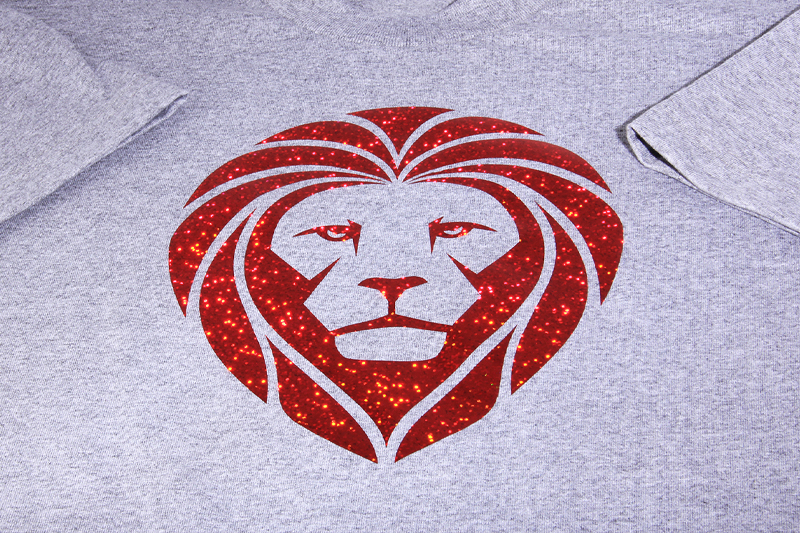
A simple red lion head on red glitter HTV
Customising apparel has a broad remit and customers may ask you to produce anything from simple letters or shapes to complex images.
The general rule here is:
- Designs with simple, clear outlines suit HTV.
- Complex or intricate designs suit DTF.
HTV: Projects with an easy-to-cut design, like numbers or letters on sportswear or images with a clear outline, are ideal for HTV as they are quick to produce, easy to weed and simple to apply.
You don’t need much experience in design either – you can do a lot just by sticking to the basics – creating a design and exporting the file so it can be read by your device. Cut lines are required but are easily added in your design software of choice and if you use a RIP like VersaWorks 6, you have options to add them directly in there.
Of course, you can bring more to your designs if you incorporate print too, either with a 2-in-1 printer/cutter or on separate devices using crop marks. Like DTF ink, modern eco-solvent inks are durable enough to withstand the heat needed to transfer the vinyl, so there’s an opportunity to create all sorts of unique and interesting products.
DTF: As DTF allows for high-resolution print with a wide colour gamut to be transferred directly from the film to the garment, it’s ideal for complex designs and outlines that are challenging to achieve
2. What Substrate Are You Using?
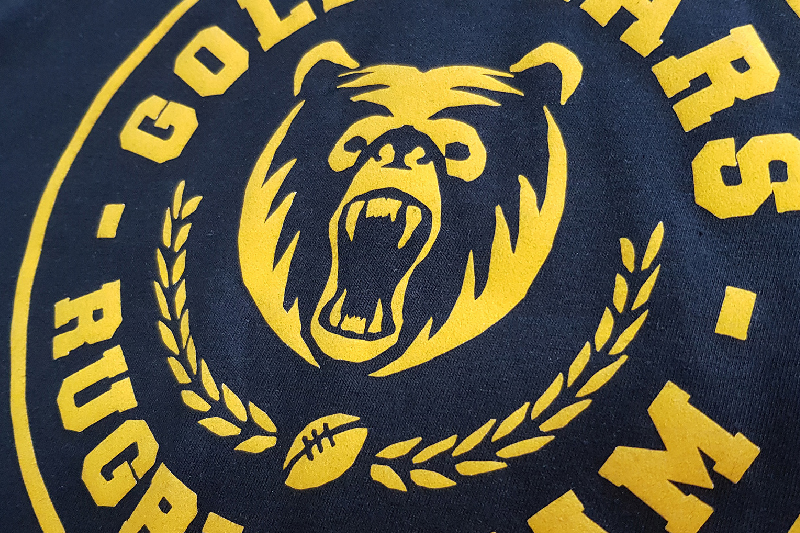
A yellow HTV logo on a dark fabric
Taking design complexity out of the equation, what do you need to consider when it comes to choosing the right print technology for your substrate?
Fabric Colour
For both technologies, opacity is the main concern when transferring to a coloured substrate.
For HTV, it’s a matter of choosing a suitable vinyl, one that is complementary to the background while having the correct opacity to produce the desired effect.
DTF on dark or coloured materials requires a white ink layer to help your image stand out. The white ink layer creates a solid, opaque background for subsequent colours to be printed on top.
Fabric Type
It's a good idea to do some practice transfers on the fabric you want to use before performing full-scale printing to be sure they are compatible, adhere well, and have the required durability.
Some fabrics might suit one method over the other for a variety of reasons (see below), but in general, both HTV and DTF comply well with most of the common garment fabrics you’d think of personalising. The biggest concern would be the fabric’s level of heat sensitivity, which is why testing is advised.
Texture
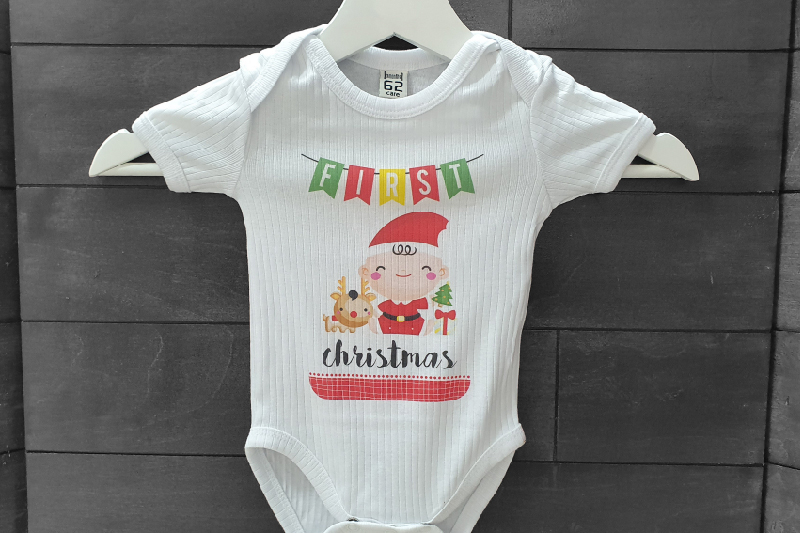
A white babygrow with textured fabric
If you prefer a smooth and flat finish on the fabric, HTV adheres to its surface and has a thin, flexible feel when properly applied. Many HTV materials can add special finishes, such as glitter, peach skin, velvet, and embossing. If you want the texture of the fibres to show through the transfer, use DTF to give it a more natural look and feel. DTF transfers are typically thin and offer a fabric-like feel after application.
Heat Sensitivity
Both HTV and DTF can be applied at lower temperatures compared with the sublimation process, reducing the risk of damaging delicate materials. Check your fabrics and confirm that they can support temperatures used in HTV and DTF.
Non-fabric Substrates
HTV is mainly used for garments and textiles; however, with a little patience, HTV can be applied to other types of non-textile surfaces with the right temperature and pressure.
Similarly, it’s possible to transfer to various hard surfaces using DTF, but this technology provides a little more flexibility. Here are some of the non-fabric applications we’ve discovered can be customised with DTF:
- Lanyards, mouse mats, umbrellas
- Leather items
- Photo albums, diaries, journal covers
- Some plastics, metals, wood, ceramics (not all so be sure to check)
3. What Are Your Production Requirements?
Both HTV and DTF solutions are ideal for low to medium-production requirements. Either method could deliver the results you want and there’s some crossover, but different benefits could push you towards one over the other.
In this section, we will discuss Roland DG’s VersaSTUDIO BN-20 and BN2-20 Series, which includes the BN-20/A and BN2-20/A printer/cutters and the BN-20D DTF printer. They look similar but are very different under the cover, designed with their specific function in mind.
Production Variety
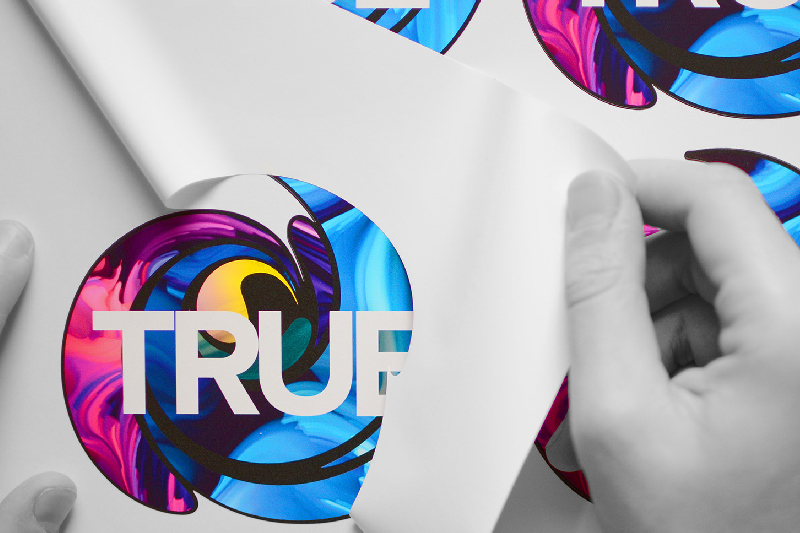
Print and cut stickers
Most businesses tend to produce more than one type of application and Roland DG’s HTV and DTF printing solutions are well-equipped to cover your requirements.
Combined printer/cutters like the BN-20, BN-20A, BN2-20 and BN2-20A are great for HTV applications as they give users cutting functionality as well as the ability to print CMYK for further customisation. Looking beyond garments, stickers are another enormously popular application that can be produced on these machines.
Similarly, the BN-20D is a DTF printer with the additional functionality of a cutter. You can use it independently as a printer or as a cutter to increase the utility of the machine. It can open up additional applications like cut vinyl decals or accent pieces to complement your existing garment designs. However, it’s worth noting that the ink is water-based, so isn’t suitable for print-and-cut applications.
Production Volume
At its most simplistic, HTV tends to be more efficient over short runs than DTF. If the task is to cut, weed and heat press, it will likely be quicker than printing on a film, adding adhesive, curing it and applying.
Generally, however, as the production volume increases, DTF becomes more efficient. It’s easier to combine steps in the process, such as printing in bulk and storing the transfers until they are needed. If you introduce more complexity, like print, to HTV, the designs will become more time-consuming and less efficient.
For high-production customers, it’s recommended that DTF devices are used with a shaker/dryer connected to the printer. It allows to operators to produce hundreds of images that can be applied later.
While regular self-maintenance is important, both machines are reliable whether they are being used daily or more sporadically. The BN-20 and BN2-20 series circulates the ink efficiently and regularly, so is capable of printing accurately even after idle periods. This is particularly important in the water-based ink of DTF and is something that differentiates the BN-20D from other DTF printers.
4. How Much Space Do You Have?
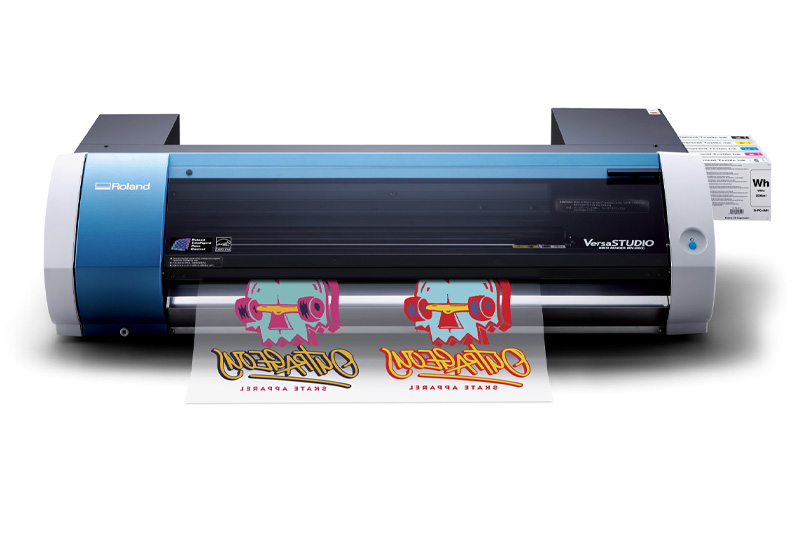
Roland DG VersaSTUDIO BN-20D DTF printer
Both HTV and DTF are ideally suited to desktop businesses. Neither method is too demanding on space so can be used wherever space is at a premium, whether that’s your spare room or the underutilised space in your studio.
The devices in the BN-20 and BN2-20 series have small footprints and the additional materials are fairly compact. It’s also worth considering whether the area you have set aside can handle your workflow, including finishing tables, heat press, tools and media.
Cost
The BN-20, BN2-20 and the BN-20D are similarly priced, but there are other costs involved in both processes that should be taken into consideration, especially for those starting from scratch.
What Equipment Do You Need for HTV?
- A cutter or printer cutter like a BN-20/A or BN2-20/A
- A computer, design software and RIP
- Eco-solvent ink if incorporating print
- Rolls of HTV material in various styles
- A heat press for applying HTV to the fabric
- Weeding and other miscellaneous tools (tape measure, scissors, lint roller etc)
What Equipment Do You Need for DTF?
- A DTF printer like the BN-20D
- A computer, design software and RIP
- DTF ink (CMYK + White)
- DTF Film
- Adhesive powder (“shake and bake” machines for applying the powder can be useful but not essential)
- An oven for melting the powder and preparing the images for application
- A heat press for applying DTF transfer to the fabric
- Miscellaneous tools (tape measure, scissors, lint roller etc)
5. How Long Should the End Product Last?
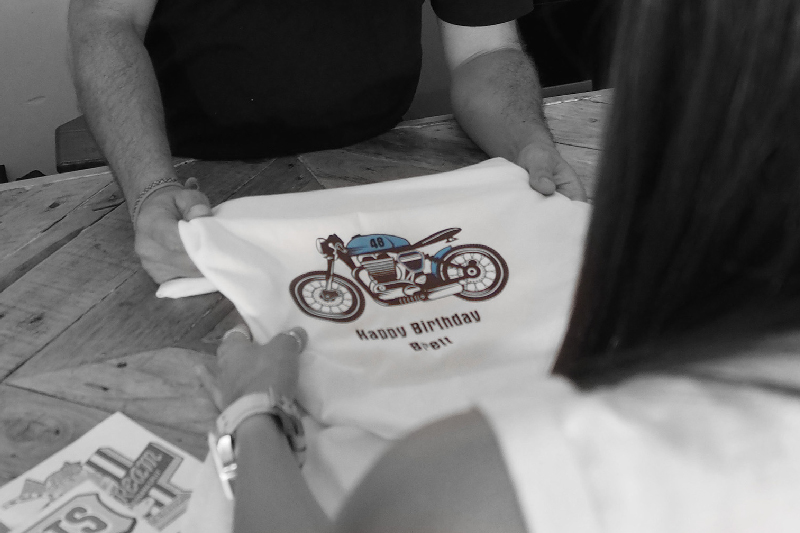
A person holding a shirt with a motorcycle on it
As with any product, there is an expectation that the transfer will last for a certain length of time under reasonable conditions. In the case of apparel, how often can it be worn and washed without the transfer fading, peeling or cracking?
The expected lifetime of a wearable garment, such as a t-shirt or sweatshirt, is between 30-50 washes.
It depends on the fabric and materials used but HTV commonly lasts somewhere between 25 and 30 washes, whereas DTF is known for being slightly more durable and has tested positively on upwards of 35 washes. The white ink layer applied on many DTF prints also adds to the durability of the ink when washing, drying, and ironing.
Always follow the manufacturers' instructions. The basic recommendations for HTV and DTF are: wash at a maximum of 30°C with the garment inside out on a short wash programme and don’t use fabric softener.
Conclusion
HTV and DTF both offer unique advantages that make them ideal for apparel customisation and more. One isn’t better than the other because they both excel at different things. Ultimately, the choice comes down to what you want to produce: design complexity, what you are transferring to and how you want to produce it.
If you’d like more information on anything mentioned in this article, please contact one of our experts.
